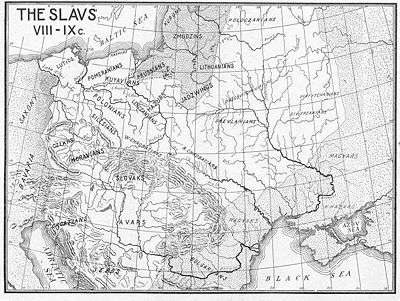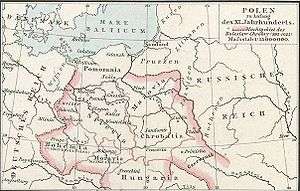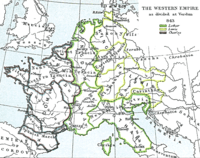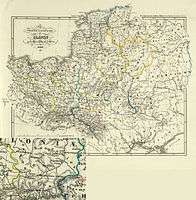White Croatia
White Croatia (also Great Croatia or Chrobatia) was the ill-defined homeland of the White Croats in Central and Eastern Europe. After the migration of the White Croats in the 7th century, it gradually lost its primacy under the influence of other Slavic peoples such as Czechs and Poles.[1] It is considered that White Croatia ceased to exist as separate ethnopolitic state in the 10th century.[1] According to the Chronicle of the Priest of Duklja, there existed another White Croatia along Red Croatia in Dalmatia.[2]
Etymology
The epithets "white" for Croats and their homeland Croatia, as well "great" (megali) for Croatia, is in relation to the symbolism used in ancient times. The epithet "white" is related to the use of colors for cardinal directions among Eurasian people. It meant "Western Croats/Croatia", in comparison to lands where they lived before. The epithet "great" signified "subsequently populated" land, but also "old, ancient, former"[3] homeland for the newly arrived Croats to the Roman province of Dalmatia.[4][5]
Location
Sources
Constantine VII in De Administrando Imperio recounts, in 30th chapter "The Story of the Province of Dalmatia", that "the Croats at that time were dwelling beyond Bagibareia (usually considered Bavaria), where the Belocroats are now... The rest of the Croats stayed over near Francia, and are now called the Belocroats, that is, the White Croats, and have their own archon; they are subject to Otto, the great king of Francia, which is also Saxony, and are unbaptized, and intermarry and are friendly with the Turks", while in 31st chapter "Of the Croats and of the Country They Now Dwell in", that "are descended from the unbaptized Croats, also called the ‘white’, who live beyond Turkey and next to Francia, and they border the Slavs, the unbaptized Serbs... ancient Croatia, also called "white", is still unbaptized to this day, as are also its neighboring Serbs... constantly plundered by the Franks and Turks and Pechenegs... live far away from sea; it takes 30 days of travel from the place where they live to the sea. The sea to which they come down to after 30 days, is that which is called dark (usually considered Baltic Sea)", while in 32nd chapter "Of the Serbs and of the Country They Now Dwell in", that "...their neighbor is Francia, as is also Megali Croatia, the unbaptized, also called ‘white’".[6] Other sources (see White Croats#Middle Ages) suggest that Croats in the 10th century lived between Moravians and Czechs on Upper Elbe, as well in Galicia in the vicinity of Kievan Rus.[7]
Dispute
In modern scholarship, the widespread opinion is that there's no simple answer on the location of White Croatia.[8] Initially was considered it was situated on the river Elbe in Bohemia, and around Vistula and Lesser Poland.[9] However, while some Polish and Czech scholars often neglected the existence of Croats in respective territories, the Ukrainian and Russian scholars consider the Croats had large and influential territories.[10]
Pavel Jozef Šafárik and Lubor Niederle placed megali Croatia in Eastern Galicia to the Vistula in the East.[11] N. P. Barsov situated the Croats in the wide area of Carpathian Mountains, on the slopes of Tatra Mountains to the river Tisza and Prut on the South, to Dniester to the East, and Vistula to the North.[11][12] O. A Kupchynsʹkyĭ considered that ethnic boundaries of Eastern Croats with West Slavs went from Prykarpattia (interfluve of rivers Laborec and Ondava until the tops of the Carpathians), valley of Beskids, Western coast of the river Wisłoka, along Sandomierz valley until middle San, near Dunajec and left coast of Vistula, while in regard to Ukraine-Slovakia border most probably upper part of Tisza river.[13] Russian archaeologist and Slavist Valentin Vasilyevich Sedov considered them as Southeastern neighbours of Dulebes living in the Northern and Southern area of Northern Prykarpattia, and along B. O. Tymoshchuk argued that Slavic Gords in Bukovina were abandoned by Croats.[12] Many other scholars also located the Croats in the territory of Galicia,[14][11] and such localization is supported by DAI according to which they were plundered by the Pechenegs which would not be possible if the Croats were located further in the West like the Czech Republic.[15] Ukrainian archaeologist and historian Orest Korčinski attribute to White Croatia several big Gords, including Revno, Stiljsko, Zhydachiv, Kotorin complex, Klyuchi, Stuponica, Krylos, Pidhorodyshche, Terebovlia, Ganachivka, Solonsko among others.[16]
In comparison, some scholars placed it on more narrow territory, from North-Eastern Bohemia to Upper Vistula.[17] This consideration is based on DAI description that they lived South-East of Bavaria, north of Hungary, and south of the White Serbs.[18] Others placed it in more broader territory, according to Francis Dvornik, White Croatia extended from Southern Bug and rivers Wieprz and San in Poland-Ukraine border, to slopes of Carpathian Mountains, including Northern part of Slovakia, then from river Netolica and Dudleba in upper Vltava, over Cidlina until Krkonoše Mountains to the North and North-West.[9] Similarly, Aleksandar V. Majorov acknowledged both the Dvornik's Croatia in the Czech Republic and Lesser Poland, and another Croatia in the Carpathians (Western Ukraine).[10] Some scholars considered that White Croatia embraced Nisa and Upper Elbe in the West, to Bug and Upper Prut and Siret in the East.[17] In other words, lands of present-day Czech Republic, Poland and Ukraine.[17] Nada Klaić considered Croats arrived from Carantania, rather than Lesser Poland.[19][20]
It is considered that in the 10th century there were only remnants of the Croats, scattered in the West in Bohemia, and another in the East in Poland, Ukraine and Slovakia.[8] This theory would abide by the tradition of using colours for cardinal directions.[21] According to the thesis, L. V. Vojtovič argued that alleged Great Croatia from the 6th century did not exist anymore in the 10th century, and in the Western part of its territory was formed White Croatia.[22]
See also
Gallery
 Slavic tribes in 8th-9th centuries;
Slavic tribes in 8th-9th centuries;
W. Chrobatians and R. Chrobatians Poland under Boleslaw Chrobry
Poland under Boleslaw Chrobry
(992-1025) Chrobatia to the East of Czechs, edited by J. B. Bury (1903)
Chrobatia to the East of Czechs, edited by J. B. Bury (1903) Belochrobates, by Antoine Philippe Houze (1844)
Belochrobates, by Antoine Philippe Houze (1844) Chrobaci around Cracow, by Karl Spruner von Merz (1855)
Chrobaci around Cracow, by Karl Spruner von Merz (1855)- Chrobatia in 1000, between Cracow and Sandomir, Gustav Droysen (1886)
References
- 1 2 Majorov 2012, p. 52.
- ↑ Gluhak 1990, p. 169–185.
- ↑ Živković 2012, p. 84–88.
- ↑ Gluhak 1990, p. 122–125.
- ↑ Hyun Jin Kim (2013). The Huns, Rome and the Birth of Europe. Cambridge University Press. pp. 146, 262. ISBN 9781107009066.
- ↑ Živković 2012, p. 49, 54, 83, 88, 111–122, 152.
- ↑ Majorov 2012, p. 52–53.
- 1 2 Majorov 2012, p. 58.
- 1 2 Gluhak 1990, p. 125.
- 1 2 Budak 2018, p. 92.
- 1 2 3 Majorov 2012, p. 54.
- 1 2 Korčinskij 2006, p. 33.
- ↑ Korčinskij 2006, p. 38.
- ↑ Korčinskij 2006, p. 31–33.
- ↑ Majorov 2012, p. 69.
- ↑ Korčinskij 2006, p. 38–39.
- 1 2 3 Majorov 2012, p. 55.
- ↑ Majorov 2012, p. 50–51, 55.
- ↑ Gluhak 1990, p. 128.
- ↑ Majorov 2012, p. 57, 63.
- ↑ Majorov 2012, p. 58–59.
- ↑ Majorov 2012, p. 59.
- Sources
- Budak, Neven (2018). Hrvatska povijest od 550. do 1100 [Croatian history from 550 until 1100]. Leykam international. pp. 86–118. ISBN 978-953-340-061-7.
- Gluhak, Alemko (1990), Porijeklo imena Hrvat [Origin of the name Croat] (in Croatian), Zagreb, Čakovec: Alemko Gluhak
- Korčinskij, Orest (2006). "Bijeli Hrvati i problem formiranja države u Prikarpatju" [Eastern Croats and the problem of forming the state in Prykarpattia]. In Nosić, Milan. Bijeli Hrvati I [White Croats I] (in Croatian). Maveda. ISBN 953-7029-04-2.
- Łowmiański, Henryk (2004) [1963-1985], Nosić, Milan, ed., Hrvatska pradomovina [Croatian ancient homeland] (in Croatian), Maveda, OCLC 831099194
- Majorov, Aleksandr Vjačeslavovič (2012), Velika Hrvatska: etnogeneza i rana povijest Slavena prikarpatskoga područja [Great Croatia: ethnogenesis and early history of Slavs in the Carpathian area] (in Croatian), Zagreb, Samobor: Brethren of the Croatian Dragon, Meridijani, ISBN 978-953-6928-26-2
- Wojciechowski, Tadeusz (2005) [1873], Nosić, Milan; Pintarić, Neda, eds., Bijela Hrvatska [White Croatia] (in Croatian), Maveda, ISBN 953-7029-02-6
- Živković, Tibor (2012), De Conversione Croatorum et Serborum: A Lost Source, Belgrade: Institute of History, ISBN 978-86-7743-096-2